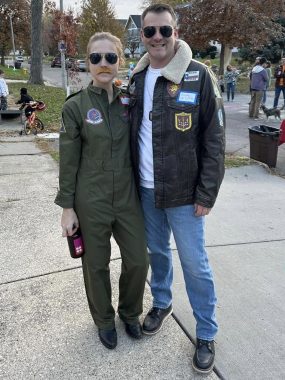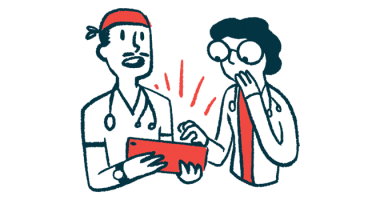A Halloween Block Party Becomes a Rare Opportunity for Anonymity
A party provides a brief respite from life with an invisible illness

Last weekend, we barricaded our street and placed tables with chairs along the curb. The distant smell of hot dogs grilling filled the air as we staked little ghost decorations along the edge of a slope in the front yard, creating a border for a stage.
Once the yard games and sidewalk chalk were in place, I stood in my driveway, surveying our setup. Neighborhood children in bandanas and tiaras were already running up and down the street. The moment I’d been planning for weeks had finally arrived — our Halloween block party.
This year, my partner and I went as Maverick and Goose from the original “Top Gun” movie. I love dressing up in costume, but it took a little bit of persuading for Michael to shave his beard and don the iconic leather jacket Tom Cruise is known for. For Goose, I wore a vintage flight suit adorned with patches, along with a blonde mustache.
When the bluegrass band members arrived, I showed them to their makeshift stage, which overlooked the street. I looked at the more than 100 people wearing costumes and street clothes, who were mostly neighborhood acquaintances. I hadn’t just thrown a block party so that I’d be among other adults wearing costumes this year. I’d papered my block with flyers because some small part of me was pretending to be “normal.” Because I knew I could hide in this crowd of people I barely knew.
As the mic was set up and the instruments tuned, I watched parents playing bean bags with their children and others heaping hot dogs onto plates. I felt liberated.
Between the pandemic and limitations of acute hepatic porphyria (AHP), I don’t get out much. I particularly don’t find myself in scenarios where I’m surrounded by strangers or appearing at least partly anonymous. I’ve designed my life around staying at home, engagements with close friends, or advocacy work, using what little extra time I have to stand up for chronic illness.
There’s a privilege that accompanies invisible illness. The majority of my neighbors aren’t aware of my regular clinic visits or weekly infusions at the chemotherapy clinic. Most of the time, I’m not outwardly disabled. In large part, I get to choose the people I bring into my inner circle, who get to learn about my rare disease and the help it might require.
Living with an illness that’s invisible comes with its share of discrimination as well, from people who don’t understand that disability doesn’t have to be visible. Last weekend, I was actively trying not to look like I was tired or in pain. I didn’t want to appear “sick” to anyone. I never want to look like I’m weak or helpless.
But I have to be careful with how I show up in the world. What I live with is invisible, but if I’m always pretending life is rainbows and butterflies, it affects not just how my neighbors treat me, but also my family members, close friends, and even doctors. With makeup and a cute hairstyle, some days I can even fool myself about needing care.
Just as I’ve tried to minimize my illness with a polished outfit, there’ve been times in my life when I let my suffering become my identity. There were days during my disease acceptance process when I embodied my illness so much that I allowed it to define aspects of myself. I internalized my AHP until I confused porphyria attacks for what makes me an interesting human.
Everyone loves a hero’s journey, where I battle my body and win. But that’s not how my story of chronic illness is written. The longer I live with AHP, the more I understand how stories of persistent pain can confuse people, including many who don’t understand the nature of not getting better or how I’ll never go back to life before rare disease. The longer I live with AHP, the less upfront I’m inclined to be with my illness history, and the more I enjoy being incognito. And given the costumes at the Halloween block party, I felt that I wasn’t the only one keeping a secret.

Claire as Goose and her partner, Michael, as Maverick from “Top Gun” at their Halloween block party this year. (Courtesy of Michael Wagler)
As the banjo picked and the fiddle piled on with a catchy melody, I found myself in rapture, floating away in the anonymity of the moment. For one night, I wasn’t known as the woman with the weird, rare disease, but as the neighbor on the corner who could draw a crowd for Halloween and host a concert on her front lawn.
Note: Porphyria News is strictly a news and information website about the disease. It does not provide medical advice, diagnosis, or treatment. This content is not intended to be a substitute for professional medical advice, diagnosis, or treatment. Always seek the advice of your physician or other qualified health provider with any questions you may have regarding a medical condition. Never disregard professional medical advice or delay in seeking it because of something you have read on this website. The opinions expressed in this column are not those of Porphyria News or its parent company, BioNews, and are intended to spark discussion about issues pertaining to porphyria.








Comments